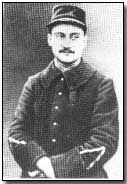The War in the Air - Summary of the Air War
 When Archduke Ferdinand was assassinated on the 28th of June 1914, it was just over a decade since the Wright brothers first twelve second flight at Kittyhawk.
When Archduke Ferdinand was assassinated on the 28th of June 1914, it was just over a decade since the Wright brothers first twelve second flight at Kittyhawk.
In the intervening years advances in range and reliability proved that the airplane was a viable, if still somewhat exotic, means of transport. In 1909 Bleriot made the first flight across the English Channel. In 1913 Roland Garros made the first cross Mediterranean flight, from the south of France to Tunisia.
There was also, in this period, some initial understanding of the military implications of the airplane. After Bleriot's flight H. G. Wells was to write, prophetically, that "…this is no longer, from a military point of view, an inaccessible island." In 1911 the Italians, at war with Turkey in Libya, became the first to make military use of the airplane, dropping grenades from a German-built monoplane. In 1912 they also dropped bombs from an airship.
When war broke out the number of aircraft on all sides and all fronts was very small. France, for example, had less than 140 aircraft at the start of the war. By the end of the war she fielded 4,500 aircraft, more than any other protagonist. While this may seem an impressive increase, it does not give a true indication of the amount of aircraft involved. During the war France produced no less than 68,000 aircraft. 52,000 of them were lost in battle, a horrendous loss rate of 77%.
The period between 1914 and 1918 saw not only tremendous production, but also tremendous development in aircraft technology.
A typical British aircraft at the outbreak of the war was the general purpose BE2c, with a top speed of 116 km/h (72 mph). Powered by a 90 hp engine, it could remain aloft for over three hours. By the end of the war aircraft were designed for specific tasks. Built for speed and manoeuvrability, the SE5a fighter of 1917 was powered by a 200 hp engine and had a top speed of 222 km/h (138 mph).
Britain's most famous bomber, the Handley-Page O/400, could carry a bomb load of 900kg (2000 lb) at a top speed of 156 km/h (97mph) for flights lasting eight hours. It was powered by two 360 hp engines.
In 1914 it was important that aircraft be easy to fly, as the amount of training that pilots received was minimal, to say the least. Louis Strange, an innovative pilot from the opening stages of the war, was an early graduate of the RFC (Royal Flying Corps) flight school. He began flying combat missions having completed only three and a half hours of actual flying time. For this reason aircraft were designed for stability. By the end of the war stability had given way to manoeuvrability. The famous Sopwith Camel was a difficult aircraft to fly, but supremely agile.
Not only did aircraft become faster, more manoeuvrable and more powerful, but a number of technologies that were common at the start of the war had almost disappeared by the end of it. Many of the aircraft in 1914 were of "pusher" layout. This is the same configuration that the Wright brothers used, where the propeller faced backwards and pushed the aircraft forward.
The alternative layout, where the propeller faces forwards and pulls the aircraft, was called a "tractor" design. It provided better performance, but in 1914 visibility was deemed more important than speed. World War One marked the end of pusher aircraft.
Another technology that scarcely survived the war was the rotary engine. In this type of engine the pistons were arranged in a circle around the crankshaft. When the engine ran, the crankshaft itself remained stationary while the pistons rotated around it. The propeller was fixed to the pistons and so rotated with them. Rotary engines were air cooled, and thus very light. They provided an excellent power-to-weight ratio, but they could not provide the same power that the heavier in-line water cooled engines could. Although they remained in use throughout the war, by 1918 Sopwith remained the last major manufacturer still using them.
The rapid pace of technological innovation was matched by a rapid change in the uses to which aircraft were put. If in 1914 there were few generals who viewed aircraft as anything more than a tool for observation and reconnaissance (and many of them had great reservation even to that use) by the end of the war both sides were integrating aircraft as a key part of their planned strategies.
While the plane did not play the decisive roll that it was to play in later conflicts, the First World War proved their capabilities. It was during this period that the key tasks that aircraft could perform were discovered, experimented with, and refined: observation and reconnaissance, tactical and strategic bombing, ground attack, and naval warfare. With the growing importance and influence of aircraft came the need to control the air, and thus the fighter was born.
Article contributed by Ari Unikoski
Next - Observation and Reconnaissance
A "dogfight" signified air combat at close quarters.
- Did you know?
